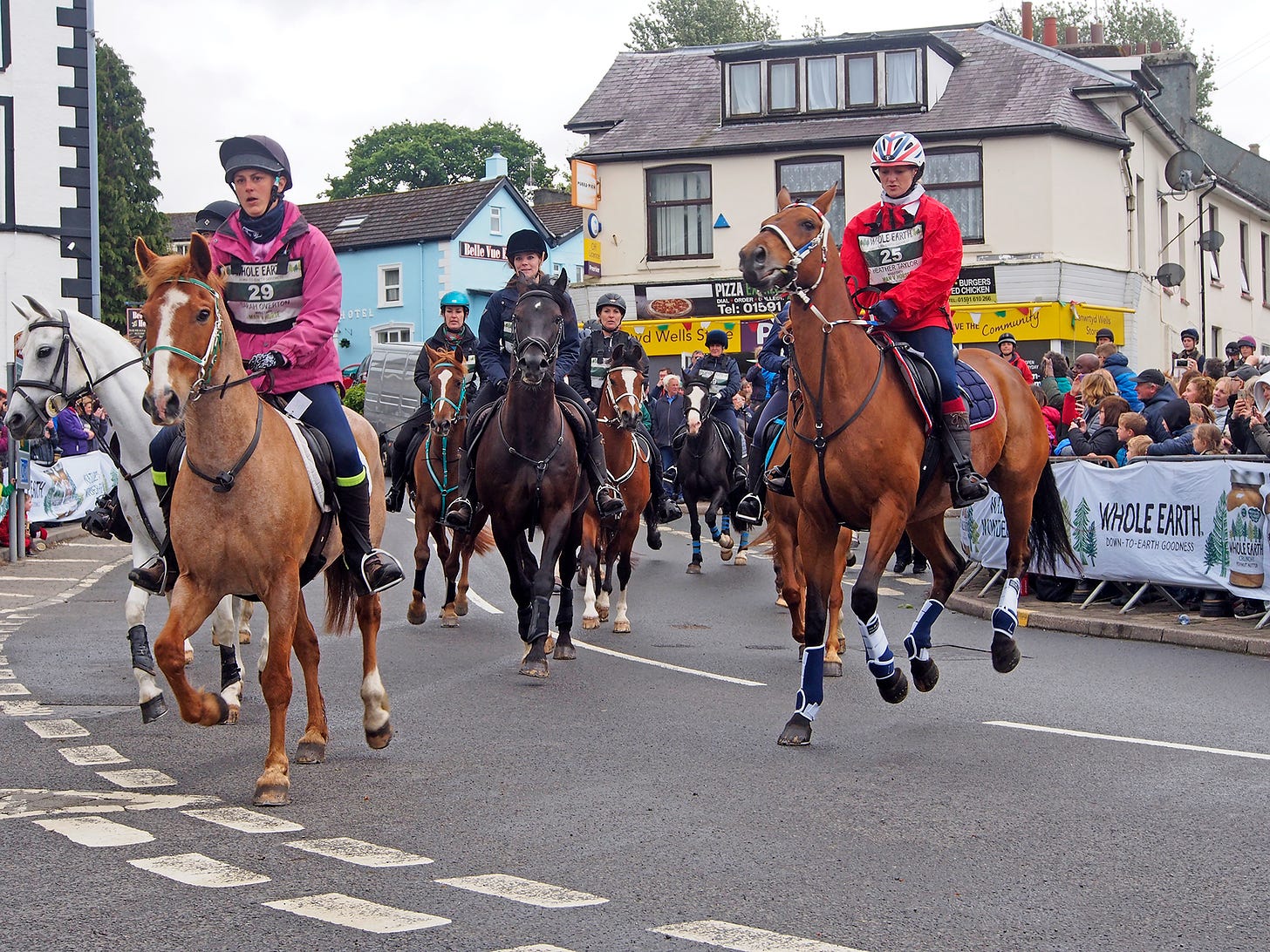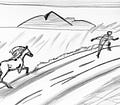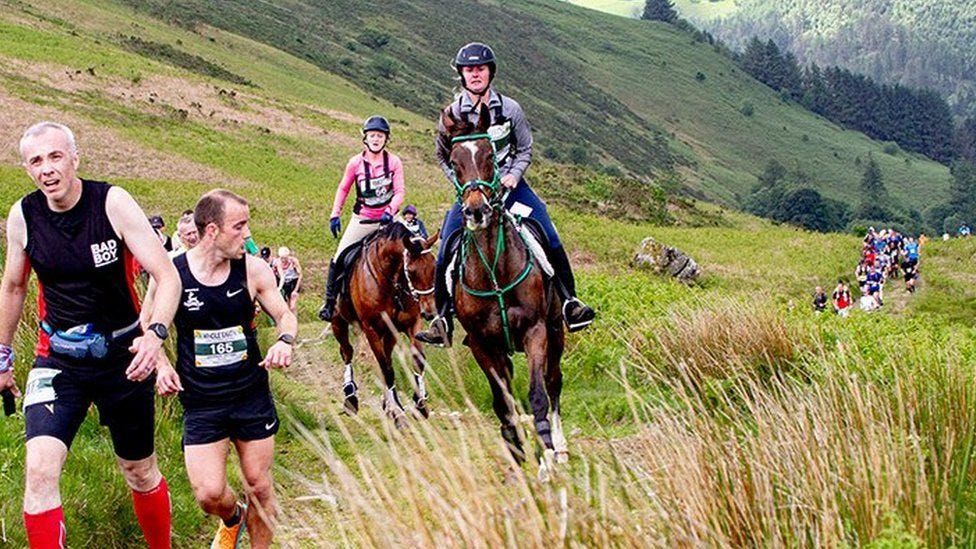Three lessons from racing against horses in Wales
Plus, the surprising results from last week’s question
Hi all,
Happy Sunday—thank you for reading Thoughts from a Bench!
In case you missed last week’s note, I had posed a unique question ahead of racing the 2023 Man v Horse Marathon last weekend:
“As some of you may know (I don’t expect this to be on your calendar…), tomorrow is the 2023 Man v Horse Marathon in Llanwrtyd Wells, Wales. I’ll be competing against ~600 runners and ~60 horses over a 22 mile course that includes country trail, rivers, roads and plenty of those green Welsh hills. Before the race (and in lieu of a post this week), I’d like to pose a question to you all… how many horses do you think I’ll beat in the race? 50? 30? 10? None? Reply to let me know… I’m just genuinely curious! And the person who guesses the closest can choose a topic for me to cover in this newsletter in the next few weeks.”
This week, the results are officially in.
I finished the race in 3 hours and 18 seconds, which counted for 29th place overall. I finished ahead of 48 horses. Some of these horse names deserve praise: Smokin Jo Li, Welsh William, and Cherry Cottage Lad are a few of my favorites.
In a unique twist of events, two submitters guessed the number of horses I would beat exactly right. Congratulations to Chris Horigan and my parents (who I promise had no insider information) for correctly guessing 48 horses. The average guess across all readers was 38 horses, with a minimum of 10 and a maximum of 60.
This was an extremely challenging course given the difficult terrain and unusually hot weather. At one point around mile 16, I realized there was no one around to cheer me on except sheep. At mile 18, as I slowly lumbered up a massive hill while my stomach growled and my calves felt like bursting, I wondered exactly why I was doing this ( though I later learned the answer). I had no choice but to slurp my sugary hydration goo and keep moving forward… or upward.
Thank you all for submitting guesses and following and supporting my journey. Today’s note is a quick reflection on the race, touching on themes of human performance, focus, and motivation that I believe relate to your pursuits as well.

#1: Man is not a machine
My roommate Dan (who unfortunately had to sit out of the race due to an injury) and I rented a Polestar electric car to drive from London to Wales for the race. We were constantly monitoring the car’s charge level to ensure we didn’t get stranded in a town with a name like Llanfair Caereinion without a charging station for 20+ miles in any direction.
Running this 22-mile race involved a similar degree of energy planning. During the first 8 miles, I was consistently evaluating my pace, forecasting whether I’d have enough “charge” to make it through to the end.
After the race, I realized there were four instances when I felt I had permanently depleted my charge. My body was cramped and exhausted, signaling me to sit down and find air-conditioning and salt. At each of those four points, though, my brain vetoed my body’s signals and told me to keep going.
I realized that man is not exactly a machine. When you feel you’ve reached your physical limit, you often have the ability to take at least one more step, and one more after that. A machine cannot exceed its clearly-defined physical limitations, but human physical limitations are less clear. With perseverance, you can seemingly stretch them, and the only way to find the exact limit is to get there.
Are your limits what you really think they are, or could you go further and faster?
#2: 3 hours in an art museum… or running across Wales
Jennifer Roberts, an art history professor at Harvard, always gives her students the same first assignment. She asks them to go to the Harvard Art Museum, pick a sculpture or painting, and look at it for 3 straight hours.
These students are learning to patiently focus on one single thing for an extended time, an important skill for uncovering the complexities and nuances in a piece of art.
(On the tube from Heathrow airport to my hotel, I had nothing to do but stare at the Piccadilly Line station map for 30 minutes, and I noticed that the “Earl’s Court” stop is spelled with an apostrophe, while nearby “Barons Court” is spelled without one. You could call me a future art critic.)
I couldn’t help but see the connection between Roberts’ assignment and this race… given I ran the course in exactly 3 hours and had no choice but to patiently focus on one thing—running—for that entire time. There were hundreds of rocks to navigate, mud pits to jump over, and cliffs to evade as I focused on putting one foot in front of the other.
I can’t think of many fulfilling, challenging accomplishments in life that don’t demand extended periods of singular focus and performance at the highest level. You might not run long distances, but you may pursue tireless negotiations, analyze large quantities of data, or work with your hands for hours at a time. In these contexts, it can be helpful to still think of yourself as an athlete or an artist, aiming to perform at the highest level in the state of intense concentration your work demands.
#3: If these races are so painful, why do you still do them?
I honestly didn’t have a great answer to this perplexing question until my roommate sent me an article about a psychological principle called the peak-end rule yesterday.
According to writer and triathlete Brittany Vermeer:
Psychological studies have shown that how a person remembers an experience may be just as important as the experience itself, and our emotions play a huge role in shaping memories. The peak-end rule is based on the idea that the most intense moments of an experience (the peaks), as well as the end of the experience (the end), have a significant impact on our perception of what happened.
After a long, tough race, the mind actually forgets most of the boring, mundane stuff. Instead, it selectively retains the highly emotional peaks, such as an especially beautiful section of trail or a particularly challenging hill, as well as the climatic ending, in which you cross the line in front of hundreds of cheering people. The emotional peaks and ending get implanted in your mind and quickly become what you hope to experience again… via another race.
Vermeer emphasizes that anyone can use the peak-end rule to help them maintain a tough training schedule. For example, you can intentionally finish a bike ride in a scenic area or while listening to your favorite playlist, creating an heroic “ending” that your mind will remember and seek to replicate again and again.
I’ll always remember the ending of Man v Horse. Three horses galloped past me with less than a mile left, looking about equally exhausted. I never thought I’d share something in common with a horse. I picked-up my pace and followed them to the finish as the crowd roared. After crossing the finish line, the race announcer walked over, microphone in hand.
“Brendan, what did you think of the race?”
I was completely hunched over, with my hands on my knees. I didn’t have to think long for an answer.
“It was brutal, but I would do it again.”
And I walked away to get a massage and a beer.
Thanks for reading! I love when these thoughts lead to conversations with readers. Did you find anything interesting or surprising? Reply to me and let me know.







